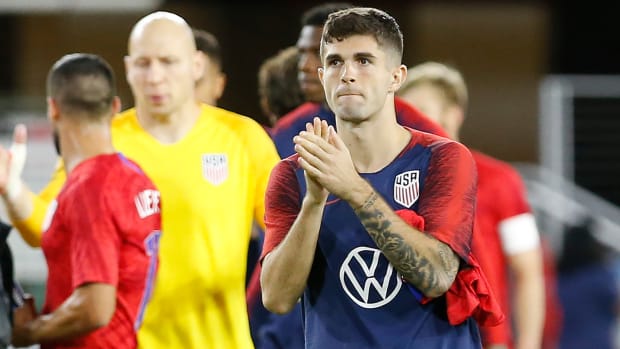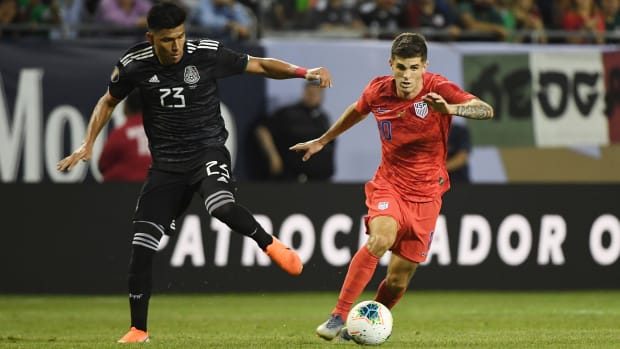The Hexagonal is out. The Octagonal is in. How does it all impact the U.S. men's national team's quest to return to the World Cup stage? As with all big changes, there are pros and cons.
For two decades, we listened to players describe Concacaf’s Hexagonal as a long road, a grind and a gauntlet.
Ten games—five home, five away—were compressed into a helter-skelter year that ended with three nations earning a ticket to the World Cup. The margins were thin, the referees were capricious and the road trips were inhospitable and daunting. The altitude at Azteca, the heat in Honduras and the problematic pitches in the Caribbean—not to mention the cheers, insults and far worse that often emanated from the stands—taxed the mind, body and point total. It was never easy.
Now, despite the pandemic that has shortened timelines and sports seasons around the world, that treacherous road has gotten longer. For the first time, Concacaf will determine its World Cup qualifiers with an eight-team, home-and-away final round. Announced Monday afternoon, the new format is the result of a revision to the previous plan that would’ve seeded the USA and Mexico directly into the Hex.
While that original plan also represented a departure from the prior six cycles, which included a six-game semifinal round, Monday’s adjustment still ensures that the Americans—who finished a humiliating fifth in the 2017 Hex—have to play four more matches than previously thought. It also means that instead of three of six teams moving onto Qatar, it’ll be three of eight (with the fourth-place finisher advancing to an intercontinental playoff).

The USA hasn’t played a game of any kind since Feb. 1. Coach Gregg Berhalter hasn’t had the chance to work with his first-choice players since last fall. Now there’s more games, more opponents and more peril standing between the Americans and a return to the world stage. And it’s all been shoehorned into a 10-month period from June 2021 to March 2022 that may still be impacted by the coronavirus. It seems like a lot to take in and a lot to negotiate.
Berhalter wasn’t so sure, however. Not everything about the new format represents a challenge.
“We know that qualifying in this region is always difficult,” he said in a U.S. Soccer Federation Q&A. “In terms of the format being more or less difficult, it’s hard to judge right now. The basic idea is that before, three out of six teams automatically qualified. That’s 50% of the teams. Now we’re at three out of eight automatically qualifying, so it’s less teams in the final group that are going to be going to the World Cup. It’s hard to get a full gauge if it’s going to be more or less difficult. We have to see who the three teams are that make up the final eight.”
The USA, Mexico, Costa Rica, Jamaica and Honduras qualified directly for the “Octagonal” based on their FIFA ranking. The remaining three teams will have to come through a two-stage, 30-team playoff. So at least the Americans won’t have to deal with that, which gives them extra time to prepare for the matches that matter most. And that’s a big part of the gray area Berhalter referenced. There’s bad and good to this new gauntlet.

THE POSITIVES
Time to prepare
Imagine if Concacaf had opted to maintain its original format—a Hex and then a parallel playoff for smaller countries—and then decided to spread it out over a longer period so that it kicked off in either October or November of this year. That would mean that Berhalter’s team, which is loaded with players with no World Cup qualifying experience, could be playing its first meaningful game in a year on the road against the likes of Mexico or Costa Rica. That would’ve represented a dramatic and harsh re-entry.
Instead, Concacaf’s decision to give 30 teams the chance to earn an Octagonal berth buys Berhalter some time. Between now and the scheduled June 2021 kickoff of Concacaf’s final round, there are FIFA international windows in October, November and March. That’s six potential games during which Berhalter can try to get the USA into qualification form, plus a possible January camp where he can work on the depth of a player pool that’ll be tested over the next two years.
The USA will have the option to schedule friendlies in October and November. European opposition will be tough to come by because the UEFA Nations League is scheduled at that time. South America’s World Cup qualifiers are set to start then as well.
“Our priority is to get games in a safe manner,” Berhalter said of the autumn windows. “We don’t want to put any players at risk, but we want to play in the October and November windows. The first thing is figuring out opponents and locations. Given what the world has been confronted with the last few months, it goes without saying that the priority is doing it in a safe way.”
Next March, the USA will participate in the inaugural Concacaf Nations League finals along with Honduras (the semifinal opponent), Mexico and Costa Rica. Those games will be played at a U.S. venue to be determined.
Rather than view the Nations League as a distraction or a superfluous and redundant competition, Berhalter sees it as a dress rehearsal.
“I think it’s a good opportunity for our group in particular to compete for a trophy,” he said. “We have a young group, and to be able to play in meaningful games where there’s a prize at the end is a good test and a good experience. It’s the culmination of the last year of hard work.”
Margin for error
Imagine also, as painful as this may be, that Couva wasn’t the end. Imagine that Bruce Arena and his staff learned from their mistakes in that night’s loss to Trinidad & Tobago—lineup rotation is good, a sturdy midfield on the road is also good—and corrected them over the final four qualifiers. Had that been possible, the USA likely would’ve gone to Russia. Instead, the national team hit a low point, leading to the departure of the long-time U.S. Soccer president and an overhaul in the program’s technical structure.
That’s a function of margin for error, and with the rise in the number of qualifiers, the room for mistakes by the presumed favorites also has increased. The additional three Octagonal participants Berhalter is waiting on won’t be better than the five already qualified. They’re ranked lower for a reason. So theoretically, given more opportunities, the favorites should get better results. Yes, that’s mitigated by the advancement percentage Berhalter also referenced. But a more talented and/or deeper team should almost always be in favor of additional opportunities to prove it.
Customs and commercials
Splitting the final round into two or three groups, which would’ve expanded the number of spots and potentially reduced the number of games, would have been a dramatic overhaul to Concacaf’s qualifying process that would’ve ended the single-table tradition along with the USA-Mexico home-and-home.
That mattered to organizers. Money also mattered, but not in a traditionally cynical Concacaf sort of way. The pandemic will have knocked nearly a year of international soccer off the books, and for many countries, the commercial rights to their home qualifiers represents a significant entry on the balance sheet. Reducing the number of matches after FIFA made two additional windows available didn’t seem like the right thing to do. If national federations benefit, and if USA-Mexico continues, that’s good for regional soccer.
“One of the things that underpins World Cup qualifying, that member associations live on, is that member associations sell their World Cup qualifying rights to whatever media, third parties, whatever. These contracts have been in place for many many years,” Concacaf president Victor Montagliani said during a conference call with media. “So when we did an analysis, it was obvious that if we went away from the spirit of the Hex, which is the home-and-away table, that if we went away from that we could be putting in peril our member associations’ ability to fund their programs. And therefore it was important for us not do that and to keep the spirit of having a final round that was a tabled version and a home-and-away between the eight teams.”

THE NEGATIVES
Wear and tear
The 14 Octagonal matches will take place across six international windows (one a double, four-game window) from June 2021 through March 2022. That includes six games combined at the beginning of September, October and November 2021. That’s a lot of travel, a lot of onerous Concacaf road trips, and a lot of long flights for the national team’s European contingent.
Last week, Berhalter described national team duty as a “commitment. It’s not for everyone.” That’ll certainly be the case next year, when many of the USA’s most talented players will have to handle the physical and mental strain of the Concacaf gauntlet. Some of those talented players have been injury prone, which also could be an issue. Because of the compressed schedule, a poorly timed injury could rule an important player out of several qualifiers
Berhalter spent most of his first year in charge getting his first-choice players used to his system. There hasn’t been time to develop the sort of proven depth or interchangeable parts that can withstand a significant amount of Octagonal adversity.
One strategy that seems almost certain is that Berhalter will wind up relying on a different pool of players for the 2021 Gold Cup. He likely won’t ask the likes of Christian Pulisic and Tyler Adams to traverse the USA over the course of a month-long tournament wedged between the World Cup qualifying competition.
“It’s going to be a balancing act,” Berhalter said. “For us, it’s about first prioritizing World Cup qualifying. We need to have our top group in for these games, and they are very important games starting in June [2021]. As we move into the Gold Cup, we know we have another opportunity to win a trophy and it may be a different group that steps up for that. For us, it would be giving players another opportunity to prove they’re good enough.”
The Olympics, a U-23 event for which clubs aren’t required to release their players, also are scheduled for the summer of 2021. Concacaf plans to stage the qualifying tournament, originally scheduled for last March, in March 2021.
Heavy on Concacaf
Events had been trending this way for a while. First, the Confederations Cup was axed. Then, UEFA launched the Nations League, after which Concacaf followed suit. Now, international windows have been lost to the pandemic.
What resulted is a U.S. schedule that’ll be very heavy on regional opposition during the buildup to the 2022 World Cup. One could make a case that games against European, South American and African opposition—even if they’re friendlies—are an important part of a Concacaf team’s preparation.
As stated, non-Concacaf opposition will be tough to schedule this October and November. Next year, every window will be occupied by Concacaf matches, with the only potential exception being an ad hoc friendly scheduled at the end of January camp (if there is one). In 2022, the year begins with the conclusion of the Octagonal and then in June, there’s the intercontinental qualifying playoffs (which the USA would play in if it finishes fourth) and the start of the 2022-23 Concacaf Nations League.
The only remaining window before the World Cup kicks off in November 2022 is in late September. That could be the next and last time the USA has the chance to face a team from Europe or South America—if it’s not used for Nations League games.
Potential pandemic problems
Montagliani said Monday that if infection, testing or travel issues remain in October and November, there is some give built into the calendar that would allow Concacaf to shift the qualifying competition’s initial group stage. A new window could be created in January 2021, for example, or existing windows could be extended.
But after that, there’s not much room in the calendar. A second wave or downturn in the region’s battle against the coronavirus could wreak havoc on qualifying (among other things).
“Knocking on wood,” Montagliani said, “If 2021 starts mimicking 2020, well then I think it’s not just Concacaf that’s back at the drawing table. It’s the entire football world.”
Concacaf’s new format essentially depends on its member nations, including the USA—whose citizens are now required to quarantine or are banned outright by numerous countries around the world—getting the virus under control. And that’s far from a certainty.
“If you’ve got to quarantine for 14 days, I’m not sure how realistic it is to run a World Cup qualifying tournament. But we’re talking about October here. We don’t know what it’s going to be like in October and as we saw from Europe things can change quickly,” Montagliani said in a later interview with Canada’s OneSoccer. “But as you see when you properly plan it, when you properly do it, you can pull it off. But, having said that, if we need to change things, we will. For now, I think it’s good we have a format. We have a plan. We have a structure so our member associations can start planning.
“FIFA nor the other confederations haven’t thought beyond 2020 in terms of losing more dates, because we would hope that we will have a solution to either deal with the situation or obviously the world has come up with a medical solution. There is a contingency plan for the short and medium term.”